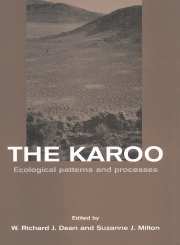Book contents
- Frontmatter
- Contents
- List of contributors
- Foreword
- Preface
- Acknowledgements
- Part one Biogeographic patterns and the driving variables
- Part two Form and function
- Part three Dynamics
- Part four Human impacts
- 15 Hunters and herders in the karoo landscape
- 16 Historical and contemporary land use and the desertification of the karoo
- 17 Alien plant invaders of the karoo: attributes, impacts and control
- Part five Comparisons
- References
- Index
16 - Historical and contemporary land use and the desertification of the karoo
Published online by Cambridge University Press: 23 December 2009
- Frontmatter
- Contents
- List of contributors
- Foreword
- Preface
- Acknowledgements
- Part one Biogeographic patterns and the driving variables
- Part two Form and function
- Part three Dynamics
- Part four Human impacts
- 15 Hunters and herders in the karoo landscape
- 16 Historical and contemporary land use and the desertification of the karoo
- 17 Alien plant invaders of the karoo: attributes, impacts and control
- Part five Comparisons
- References
- Index
Summary
Introduction
During the last 100 years, concerns over the degradation of the karoo have had a major impact on the development of agricultural policy for South Africa. Government commissions of inquiry into stock disease (Anon, 1877), drought (Anon, 1923) and desert encroachment (Anon, 1951) and other state agricultural initiatives such as the 1960s Stock Reduction Scheme (Pringle et al., 1982), the privatization of karoo communal lands (Boonzaier et al., 1990) and the National Grazing Strategy (Du Toit et al., 1991) have all either highlighted the desertification issue or have sought to limit the rate and extent of karoo degradation. Unlike the Sahel, for example, where there has been a significant decrease in annual rainfall since 1966 (UNEP, 1992), the perceived negative changes in the karoo landscape and declining agricultural productivity have been attributed directly to agricultural impacts, and in particular to overgrazing (Acocks, 1953; Dean and Macdonald, 1994). It is generally believed that it has been the mismatch of agricultural land use practices with the production potential of the land which has led to widespread desertification in arid and semi-arid South Africa (Milton et al., 1994b; Badenhorst, 1995). Although this is a powerful indictment against the stewardship of the many generations of South Africans who have lived off the karoo, it is important to assess its veracity. To do this we need to understand how karoo landscapes have been utilized in the past and to assess the ecological impact of contemporary agricultural practices on the region.
There are two main agricultural production systems in the karoo with widely differing histories, forms of land tenure, institutional arrangements, land use practices and production objectives.
- Type
- Chapter
- Information
- The KarooEcological Patterns and Processes, pp. 257 - 273Publisher: Cambridge University PressPrint publication year: 1999
- 31
- Cited by



